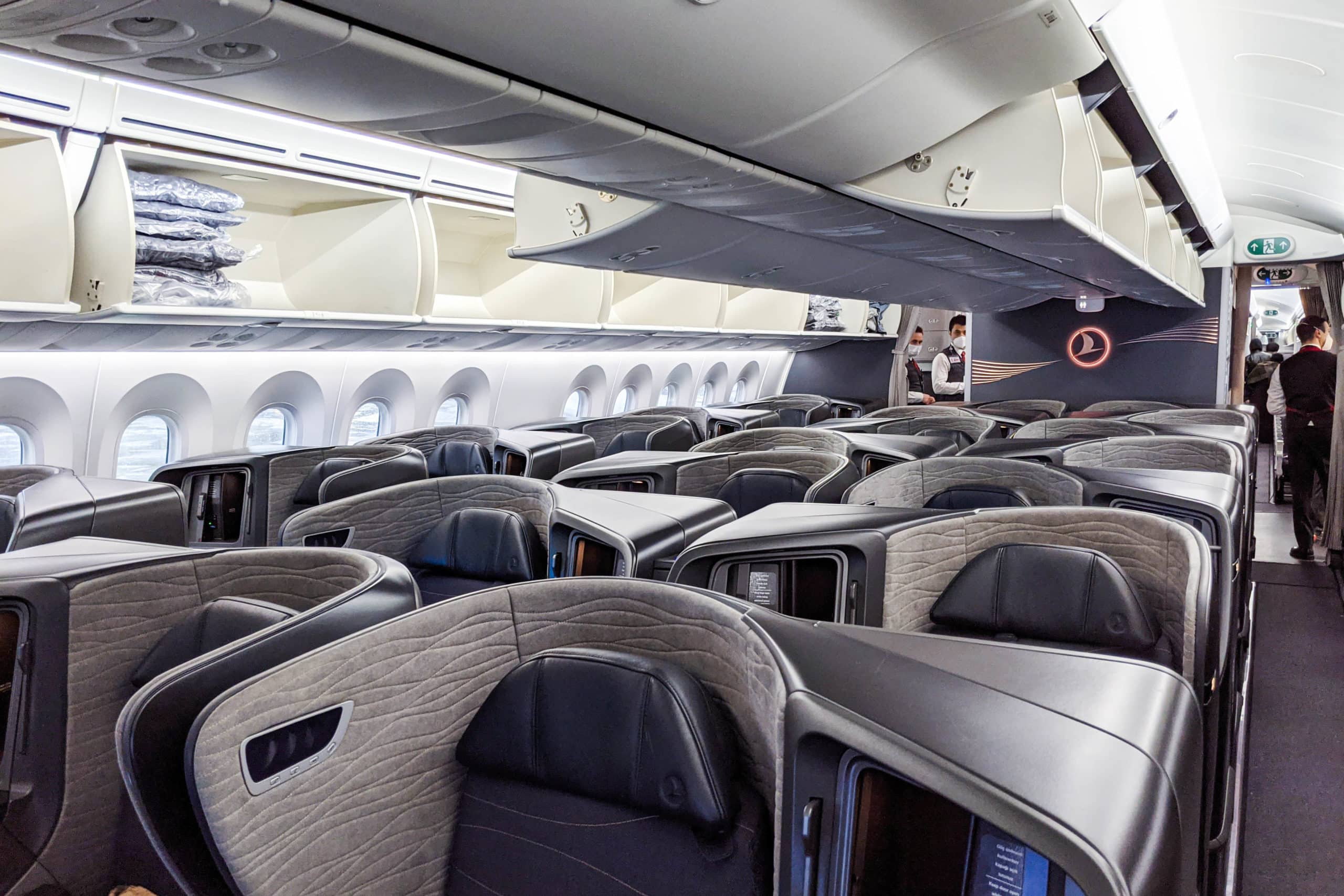After a brief but very comfortable stay at the Turkish Airlines Business Lounge in Istanbul, we continued onward to Malé with Turkish Airlines. Having arrived on a Boeing 787 Dreamliner, we were treated to an entirely different cabin on board the Boeing 777.
Rather than doing a complete review of the flight on the Boeing 777, which Ricky has done previously, I thought it would be valuable to compare the flight experience on both aircraft, which is a question that comes up often in my Points Consulting calls.
Let’s have a look at the similarities and differences between flying Turkish Airlines business class on a Boeing 787 Dreamliner and a Boeing 777.
The Routes
Of particular interest to this post is that Turkish Airlines flies different aircraft to different cities. As we’ll see, the assigned aircraft isn’t always consistent.
In Canada, Turkish Airlines flies to Montreal, Toronto, and Vancouver. Toronto has consistently had the 777 scheduled on the route, while Montreal has alternated between the Boeing 787 Dreamliner, Airbus A330, and the Airbus A350 since the route launched.
The Vancouver route was originally served by the Boeing 787 Dreamliner, but has since been swapped to a mix of the A350 and the 777.
Turkish Airlines also flies to a number of hubs in the United States. On some routes, there are multiple flights per day, and on these routes, they may fly a 787 on one flight and a 777 or A330 on the other.

Furthermore, the airline may also change the aircraft scheduled on a particular route at any given time.
If you’re set on flying a particular product, it could be worthwhile to set up an Aircraft Change Alert on ExpertFlyer. This way, you won’t be surprised to board a 777 when you were originally booked on a 787.

If you don’t have a subscription to ExpertFlyer, you can determine which aircraft is scheduled on your flight by using the filters on the Aeroplan search page.
On the search results page, click on “More options”, and then click on “Aircraft type”. The aircraft type will then be displayed under the airline’s logo and flight number.

The Cabin
Let’s start the comparison by looking at the two different cabin layouts.
The Turkish Airlines 787 Dreamliner has 30 business class seats spread across eight rows in a single business class cabin. The pod seats are laid out in a 1-2-1 configuration, with each seat offering aisle access.

The A and K seats sit next to windows, while the D, E, F, and G seats are paired in the middle of the cabin.
Odd-numbered window seats have seats that directly border the aisle, while even-numbered window seats are tucked in closer to the window.
Odd-numbered middle seats (seats E and F) are close to their neighbouring seats, while even-numbered middle seats (seats D and G) are situated closer to the aisles.
By contrast, the cabin configuration of the Boeing 777 is vastly different. Broadly speaking, the design is more dated and less private than that of the Dreamliner.
Turkish Airlines 777 business class has 49 seats spread out across two cabins and seven rows. These lie-flat seats have a 2-3-2 configuration.

While the Dreamliner’s seats change between odd- and even-numbered rows, the seats on the 777 are consistently the same. Notably, on the 777, passengers in seats A, E, and K do not have direct aisle access.
In comparison to different Turkish Airlines configurations, a similar cabin layout to the Dreamliner may be found on the Airbus A350. Meanwhile, a similar cabin layout to the 777, albeit in a 2-2-2 configuration, may be found on the Airbus A330.
So, if you’re not scheduled to fly on either the Dreamliner or the 777, this guide can be used as a reference between the other aircraft configurations, too.
The Seat
As with the overall cabin layout, the seat features vastly differ between the Dreamliner and the 777.
Upon first glance, the 777 has significantly more room than the 787. The open-space design of the seat leaves plenty of room to comfortably stand up and walk around, while the design of the 787 seat doesn’t have much available room.


In terms of specifications, in lie-flat mode, the seat on the Dreamliner is 76 inches long and is 20.1 inches wide. The bed on the 777 is 78 inches long and 22 inches wide.


Both seats fully recline to a lie-flat bed, although the seat on the 777 offers more real estate.
Storage
In terms of storage, the 777 has an ottoman that can comfortably fit a carry-on bag, an open storage space just above the ottoman, and storage space under the armrest.
On the 777, the universal outlet, USB port, and headphone jack are located in the storage space under the armrest. These are much easier to access on the Dreamliner, with the universal outlet and USB port located in the storage locker, while the headphone jack is next to the seat controls below the surface space.


By contrast, the 787 has much less storage space, limited to space under the footwell, a small storage compartment, and the slim literature pocket.


Surface space
For surface space, the Dreamliner has a small area with a beverage indentation located on the aisle side of the seat in even-numbered rows and on the window side in odd-numbered rows.

The 777 has some surface space by the armrest, which is shared with your seatmate, but it’s not enough to conveniently store something like a laptop during a meal.

Tray table
The tray table pops out from under the entertainment screen on the Dreamliner, and from a compartment attached to the armrest on the 777.
On both aircraft, the tray table can be slid forwards and backwards, should you wish to leave your seat with the tray table out. This is much easier to do on the 777 than on the Dreamliner, though, given the open-space design of the seats.


Seat controls are located below the surface space and above the entertainment control on the Dreamliner. On the 777, they’re located just in front of the beverage holder on the surface space.
Entertainment
The entertainment screen on the Dreamliner is 18 inches, while on the 777 it is 15.4 inches (and much farther away).


One feature of the Boeing 787 Dreamliner that I love is the dimmer control underneath the window. It’s nice to be able to see outside without having intense glare. There is an all-or-nothing window shade on the 777.

Restrooms
In terms of restrooms, the Dreamliner has one restroom available in the front of the business class cabin, while the 777 has a total of two that aren’t shared with passengers travelling in economy.
Of these, the restroom in the 777 is substantially larger. I found it difficult to change into sleepwear in the Dreamliner’s restroom, which was very cramped and didn’t have a fold-down bench.

By contrast, the 777’s restroom is much more spacious and has a bench, as well as a fake window with a wing-tip view that gives the illusion of travelling in economy.


Which Aircraft Is Superior?
Prior to flying back-to-back with Turkish Airlines on their Dreamliner and the 777, I would likely have considered the Dreamliner to be the clear winner. In retrospect, each aircraft has advantages and disadvantages, and what I consider to be a plus might be a minus to someone else.
In terms of overall cabin design, I liked the sleek, modern look of the Dreamliner over the more dated look of the 777. The bronzed Turkish Airlines logo at the rear of the Dreamliner business class cabin really stands out and contrasts with the blacks and greys in the rest of the cabin.


As with most modern business class products, having direct aisle access in every seat is a nice, if not necessary, feature. This gives another advantage to the Dreamliner.
Unless you’re travelling with someone you know, climbing over a stranger on the 777 isn’t a fun task, especially if you happen to trip or hit turbulence mid-way through your onboard hurdling.
For those who value privacy, the Dreamliner offers a more competitive edge than the open design of the 777. This is especially the case if you choose a window seat in an even-numbered row, as you’re tucked away close to the window and hidden from the view of most passengers.

When it comes to overall room and bed design, though, one could easily argue that the 777 is superior.
Some passengers remark that the footwell in the Boeing 787 Dreamliner is constricting and uncomfortable. While I didn’t find this to be the case, sleeping on the 777 doesn’t involve any restrictive footwell whatsoever.
In fact, I found the bed on the 777 to be more comfortable than the one on the Dreamliner, as I could shift from side to side without brushing against the seat’s walls, as happened on the Dreamliner.
If you’re an individual who tends to take up more real estate, then I believe the 777 would offer a more comfortable sleep. If you’re travelling with someone else, then at least the proximity to your neighbour wouldn’t be awkward, too.

Furthermore, the business class seat on the 777 just feels much larger than the Dreamliner’s business class pod. It’s also nice to have an ottoman in which you can store your stuff, rather than in the overhead bin or underneath the footwell as on the Dreamliner.
If I had to choose, I would opt to fly on the Dreamliner, as I’m not someone who takes up a lot of space on the aircraft. As a light sleeper, I value being secluded from the aisles when passengers might brush my legs.
In both cases, I know that I’d be afforded good food, service, and slippers on board the flight.
Conclusion
On our way to the Maldives, we flew back-to-back overnight flights with Turkish Airlines in business class. Our flight from Vancouver to Istanbul was on the Boeing 787 Dreamliner, while our flight from Istanbul to Malé was on the Boeing 777.
It was interesting to fly these aircraft sequentially. While they were both perfectly comfortable ways to fly overnight, long-haul flights, I’d choose the Dreamliner for the reasons mentioned above if I had to make a choice.
Following our two Turkish Airlines flights, we were teeming with excitement as we arrived in the Maldives, looking forward to five nights of bliss at Le Méridien Maldives Resort & Spa.


